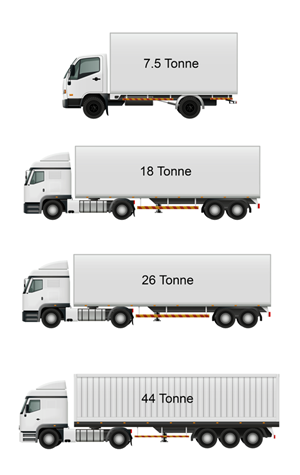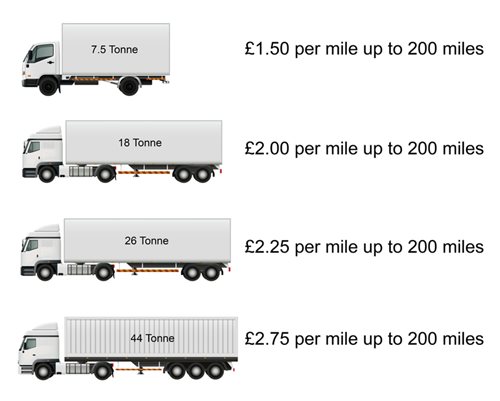We have created this helpful pricing guide to get you started and walk you through how to price a HGV load.
Different factors to bear in mind when quoting for HGV load haulage work
Two of the most important factors to bear in mind when setting a price for your HGV load is how urgent the requested delivery is, and what capacity you have at the time of the request. If, for example, it is 4pm and the client needs a truck into his customer by 6pm when they close, you may want to add a premium due to the late notice.
If you have just one truck without a job for the next day and your client wants to book a job that you do not particularly want to take, you may want to quote a higher price with the intention of making that job worthwhile.
You may find that your client wants to book just 10 pallets and all you can offer is an articulated truck with a carrying capacity of 26 pallets. If that were the case, you may be able to charge the rate you would usually charge for the larger HGV vehicle.
The size of a load is the main factor in choosing which vehicle will be required. The weight of the HGV load will also be a major factor in your quotation. Below is a list of vehicle types and the weight they can carry:

If the load you are about to quote on can be collected locally to where you are based or where your truck is being emptied, you could base your quote on the following chart per mile:

7.5 tonne - £1.50 per mile, up to 200 miles
18 tonne - £2.00 per mile, up to 200 miles
26 tonne - £2.25 per mile, up to 200 miles
44 tonne - £2.75 per mile, up to 200 miles
If the journey is over 200 miles, you could offer a reduction of 50% for each extra mile covered up to a specified maximum distance.
If your drivers are not in a sleeper cab and cannot stay overnight in the truck, you may want to offer a maximum distance of 250 miles in a day so that your driver can return to base within their normal working day. Need help understanding the HGV working hours regulations? View our simple but comprehensive guide on this here.
However, if your driver can stay in the truck overnight, you should add an overnight charge of £50 based upon the provision that you can find a return load the following morning.
You may also need to consider other charges such as toll roads or crossing charges over rivers, as these are all factors that can increase the price you should charge for haulage work. The main factor that can bring costs down is flexibility by your client, so if they offer you a few days in which to collect the goods and a few days to deliver, you may want to reduce the cost because you can fit this load in with other work.
In recent years, transport companies have been able to join pallet member networks, or have been able to input pallets into a network through other hauliers who are members. This means that you can offer your clients a fixed price per pallet as you will be able to consolidate freight.
Competitive overnight pallet rates
For standard pallets to zone 1, which covers most of the UK but does not include outlying regions such as West Wales or North Scotland, a standard yet competitive charge to ask would be somewhere between £50–£60 per standard 1,200 x 1,000 pallet up to 1,500 in height.
Oversized and timed delivery slots
An aspect to look out for when pricing pallet work is oversized pallets which might take up two spaces on a trailer. This is because you could be charged more by the hub or the delivering depot. Also, if there is a specific time allotted to the delivery, you should charge a delivery timed slot of between £10–£15 approximately.
Pallets into Europe
For pallet deliveries into Europe (the main EU countries such as Germany, France, Italy, Spain, Portugal etc.), you need to quote your client and base the delivery time on around 3–5 days depending on destination. If the delivery is urgent, you may want to offer a direct delivery service via a van. To quote for a long-distance delivery on a van, you will need to account for ferry crossing charges and toll roads on the continent.
You also need to be aware of bank holidays in continental countries, as these differ from the UK and some vehicles may not be allowed to travel on bank holidays.
Volumetric weight explanation
A volumetric calculation consists of length x width x height and is often referred to as L x W x H. Goods going to Europe are often described in metric rather than imperial measurements and, as a rule of thumb, 1m = 3.3ft. A standard pallet is 1,200 x 1,000 base size.
For example, if you are quoting on a pallet of goods that weighs 880kg and measures 120cm x 100cm x 220cm, your volumetric calculation will look like this: 1.2 x 1 x 2.2 = 2.64. In this example, the haulage costs will be calculated as if the pallet of goods weighs 880kg.
Most trailers both in the UK and on the continent are 13.6m in length and can carry 26 standard pallets on the floor. Many trucks have a second floor which comes down internally and some trailers can be double-deck or even triple-deck trailers in some cases. Therefore, as long as the weight is within the allowed limit, which can be up to around 28 tonnes, you could potentially transport 26 pallets x 3 = 78 pallets on a single load.
The rule of thumb is that the more pallets you can transport on a single load, the more profit you will make. You will have a greater opportunity to reduce the price per pallet to your client, and therefore be more competitive in the market.
Smaller rigid trucks, like a 6-wheel rigid, can carry 16 pallets on the bed of the truck and up to 16 tonnes in weight, depending on the weight of the body unloaded.
Removals
Removals are a specialist business and general HGV load haulage companies do not generally offer a removal service. Specific types of lorries need to be used to do removals, as personal items and furniture may need to be tied to the inside of the truck to stop them from moving around during transport.
In conclusion
There are key elements to consider when pricing a transport job and these are as follows:
- The type of vehicle which will be needed to transport the goods.
- The distance of the transport request.
- The urgency of the job.
- The availability of your vehicles at the time of the request.
- Where the load is going because, if your vehicle ends up empty in a remote destination, you may have to travel miles to get a return load.
Let’s assume that you want to put a rate schedule together for a new or existing customer and the criteria is that the client gives you a minimum of a one-day warning of each job and that the job can be loaded on day 1 and delivered on day 2. This is a good way to work out what to charge.
Open a new spreadsheet and decide how much you want per mile for each type of van or truck. Let’s imagine that, for a transit van, you need £1.50 per mile and for a 44-tonne artic and trailer, you need £3.00 per mile. Simply put the type of vehicle down one side of the spreadsheet and put the mileage along the top of the spreadsheet.
So, 100 miles for a transit van would cost the customer £150 and 100 miles for a 44-tonne artic and trailer would cost the customer £300. As a rule of thumb, the types of vehicles you could add into your spreadsheet are as follows:
- Small van (such as Belingo or Escort van)
- Larger van (such as short wheelbase or long wheelbase transit)
- 7.5-tonne truck (payload of around 3.5 tonnes)
- 18-tonne rigid truck (payload of around 10 tonnes)
- 26-tonne rigid truck (payload of around 16 tonnes)
- 44-tonne rigid truck (payload of around 28 tonnes)
Now you need to consider which parts of the country are more remote than others. For example, if your customer asked for a price on a load from Reading to Manchester (around 200 miles), neither destination is remote and therefore you should be able to get a backload via an online freight exchange such as Returnloads to eliminate the dead mileage. You can take finding an owner driver wanted job into consideration on your rate.
However, if your customer asks for a price from Reading to Fishguard in West Wales, which is a similar distance of around 200 miles, you should not charge the same mileage rate because you might find it difficult to get a backload from West Wales and may have to travel a distance in order to pick up a good return journey.
Therefore, you need to zone your rate schedule and put areas in the UK which are more remote in a higher zone, regardless of distance. For example, Manchester, Birmingham, Leeds and other main cities would be in zone one but Fishguard, Penzance and Barnstaple, for example, might be in zone two or zone three. As a general rule of thumb, you should consider the return load charge as around 60% of the outbound charge. For example if you priced a job on your rate schedule from Reading to Manchester as £600 for a 44-tonne unit and trailer, you would assume that your backload from Manchester area to Reading would be somewhere between £320 and £380.
Calculating the cost of haulage work can be difficult and time consuming, a Transport Management System can take the time and effort out of cacluating haulage costs, but will also ensure your customers are charged consistent rates. Want more information? Visit the Mandata website to see how Mandata Go and Mandata TMS will help you streamline your processes including pricing haulage work.